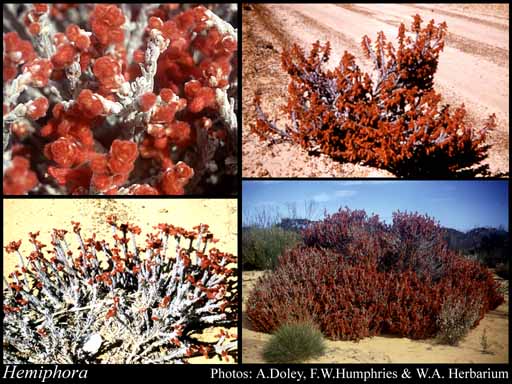- Reference
- Syst.Census Austral.Pl. p103 (1883)
- Name Status
- Current

Scientific Description
Family Lamiaceae.
Sometimes included in Chloanthaceae, Verbenaceae.
Habit and leaf form. Shrubs; evergreen; without essential oils; resinous (viscid or glutinous), or not resinous. ‘Normal’ plants to switch-plants (somewhat switch-plant-like, owing to sparse leaves and broom-like habit). Leaves well developed, or much reduced. Plants unarmed. Leaves cauline. Young stems cylindrical. Stem internodes solid (woody). To 0.3–0.45 m high. Leptocaul. Leaves small; opposite, or whorled; decussate; 3 per whorl; not decurrent on the stems; leathery; sessile; aromatic, or without marked odour; simple; epulvinate. Leaf blades entire; solid (almost terete); semi-terete; linear, or linear to lanceolate; linear; cross-venulate (unicostate). Mature leaf blades adaxially woolly (distinctly bullate-rugose); abaxially woolly (densely). Leaves without stipules. Leaf blade margins crenate; revolute. Leaves without a persistent basal meristem. Leaf anatomy. Hairs present; glandular hairs absent; complex hairs present, or absent. Branched hairs absent. Complex hairs stellate. Stem anatomy. Secondary thickening anomalous; via concentric cambia.
Reproductive type, pollination. Fertile flowers hermaphrodite. Unisexual flowers absent. Plants hermaphrodite. Plants not viviparous; heterostylous.
Inflorescence and flower features. Flowers solitary; axillary. Inflorescences flowers axillary, solitary. Flowers pedicellate (shortly); bracteate; bracteolate (2-lateral). Bracteoles not adnate to the receptacle. Flowers medium-sized; very irregular; zygomorphic. The floral asymmetry involving the perianth and involving the androecium. Flowers 5 merous; cyclic; tetracyclic. Free hypanthium absent. Hypogynous disk absent. Perianth with distinct calyx and corolla; 10; 2 -whorled; isomerous. Perianth members entire. Calyx present; 5; 1 -whorled; gamosepalous; deeply 5- blunt-lobed, or toothed; exceeded by the corolla; cyathiform; regular; persistent; non-accrescent. Calyx lobes linear (or oblong linear). Corolla present; 5 (the upper lip 2-lobed, the lower 3-lobed, the lobes almost identical); 1 -whorled; gamopetalous; blunt-lobed, or toothed; imbricate; bilabiate; hairy abaxially; glabrous adaxially (except a dense hairy ring above the ovary); red to purple (claret coloured), or yellow (occasionally); deciduous. Corolla lobes oblong to ovate, or triangular (more or less). Corolla members entire. Androecium present. Androecium 4. Androecial members adnate (epipetalous); markedly unequal; free of one another; 1 -whorled. Androecium including staminodes. Staminodes 2. Stamens 2. Staminal insertion near the base of the corolla tube to midway down the corolla tube. Stamens becoming exserted; didynamous; all more or less similar in shape; reduced in number relative to the adjacent perianth; oppositisepalous. Filaments glabrous; filiform. Anthers dorsifixed (anthers 2-lobed; lobes free in the lower halves); dehiscing by longitudinal valves. Gynoecium 2 carpelled. The pistil 4 celled. Carpels reduced in number relative to the perianth. Gynoecium syncarpous; synstylovarious (styles free in upper part); superior. Ovary plurilocular; 2 locular (morphologically), or 4 locular (ostensibly, via false septa). Locules secondarily divided by ‘false septa’. Gynoecium median. Ovary summit hairy, the hairs not confined to radiating bands. Gynoecium stylate. Styles 1; simple; attenuate from the ovary; apical; much longer than the ovary at anthesis; not becoming exserted; hairless (glabrous). Stigmas 2; 2 - lobed (minutely). Placentation axile. Ovules 1 per locule (ostensibly, i.e. per locellus), or 2 per locule (per carpel); non-arillate; hemianatropous.
Fruit and seed features. Fruit falling from the plant before the next growing season; non-fleshy; indehiscent; a drupe. The drupes with separable pyrenes (two). Fruit 4 celled; 4 locular. Endocarp not ribbed. Dispersal unit the mericarp. Fruit 1–4 seeded. Seeds 2 or more per mericarp (2). Seeds endospermic. Embryo straight.
Special features. Calyx limb 5 lobed. Corolla tube exceeding the calyx; straight. The upper lip of the corolla incorporating 2 members, the lower 3; (posterior, adaxial) lip of the corolla bilobed; upper (adaxial) lip of the corolla not concave. Lower (abaxial) lip of the corolla 3 lobed; not concave.
Geography, cytology, number of species. Native of Australia. Endemic to Australia. Australian states and territories: Western Australia. Eremaean Botanical Province. A genus of 1 species; 1 species in Western Australia; 1 endemic to Western Australia.
Etymology. From the Greek for "half" and "to bear"; the genus has only two stamens, whereas most others in the family have four.